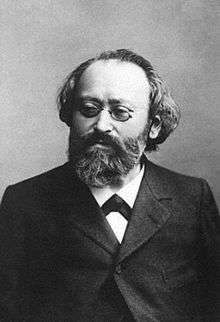Violin Concerto No. 1 (Bruch)
| Violin Concerto | |
|---|---|
| by Max Bruch | |
 | |
| Key | G minor |
| Catalogue | Op. 26 |
| Period | Romantic |
| Genre | Concerto |
| Composed | 1866 |
| Movements | 3 |
| Scoring | Violin & Orchestra |
| Premiere | |
| Date | April 24, 1866 |
Max Bruch's Violin Concerto No. 1 in G minor, Op. 26, is one of the most popular violin concertos in the repertoire. It continues to be performed and recorded by many violinists and is Bruch's most famous composition.[1]
History
The concerto was first completed in 1866 and the first performance was given on 24 April 1866 by Otto von Königslow with Bruch himself conducting. The concerto was then considerably revised with help from celebrated violinist Joseph Joachim and completed in its present form in 1867. The premiere of the revised concerto was given by Joachim in Bremen on 5 January 1868 with Karl Martin Rheinthaler conducting.[2]
The fate of the score
Bruch sold the score to the publisher N. Simrock outright for a small lump sum — but he kept a copy of his own. At the end of World War I, he was destitute, having been unable to enforce the payment of royalties for his other works because of chaotic world-wide economic conditions. He sent his autograph to the duo-pianists Rose and Ottilie Sutro (for whom he had written his Concerto in A-flat minor for Two Pianos and Orchestra, Op. 88a, in 1912), so that they could sell it in the United States and send him the money. Bruch died in October 1920, without ever receiving any money. The Sutro sisters decided to keep the score themselves, but they claimed to have sold it, and sent Bruch's family some worthless German paper money as the alleged proceeds of the alleged sale. They always refused to divulge any details of the supposed purchaser. In 1949, they sold the autograph to Mary Flagler Cary, whose collection, including the Bruch concerto, now resides at the Pierpont Morgan Public Library in New York City.[3]
Instrumentation
The work is scored for solo violin and a standard classical orchestra consisting of two flutes, two oboes, two clarinets, two bassoons, four horns, two trumpets, timpani, and strings.[2]
Movements
The concerto is in three movements:
The first movement is unusual in that it is a Vorspiel, a prelude, to the second movement and is directly linked to it. The piece starts off slowly, with the melody first taken by the flutes, and then the solo violin becomes audible with a short cadenza. This repeats again, serving as an introduction to the main portion of the movement, which contains a strong first theme and a very melodic, and generally slower, second theme. The movement ends as it began, with the two short cadenzas more virtuosic than before, and the orchestra's final tutti flows into the second movement, connected by a single low note from the first violins.
The slow second movement is often admired for its melody, and is generally considered to be the heart of the concerto. The themes, presented by the violin, are underscored by a constantly moving orchestra part, keeping the movement alive and helping it flow from one part to the next.
The third movement, the finale, opens with an intense, yet quiet, orchestral introduction that yields to the soloist's statement of the energetic theme in brilliant double stops. It is very much like a dance that moves at a comfortably fast and energetic tempo. The second subject is a fine example of Romantic lyricism, a slower melody which cuts into the movement several times, before the dance theme returns with its fireworks. The piece ends with a huge accelerando, leading to a fiery finish that gets higher as it gets faster and louder and eventually concludes with two short, yet grand, chords.
Bruch also composed two more violin concertos, but neither has gained as much fame as his first.
References
- ↑ Ezard, John (April 26, 2000). "Bruch still No 1 in classic hall of fame". The Guardian. Retrieved May 2013. Check date values in:
|access-date=(help) - 1 2 Steinberg, M. The Concerto: A Listener's Guide, OUP (1998)
- ↑ "Knoxville Symphony Orchestra program notes – Beethoven & Bruch". Archived from the original on July 13, 2011. Retrieved May 2013. Check date values in:
|access-date=(help)
External links
- Violin Concerto No.1, Op.26: Scores at the International Music Score Library Project
- Potter, Tully (2016). Bruch: Violin Concerto Nº. 1 & other works (PDF) (CD). Hyperion Records. CDA68060.
- Rodda, Dr. Richard E. (2011). "Violin Concerto No. 1 in G minor, Op. 26". John F. Kennedy Center for the Performing Arts. Retrieved May 2013. Check date values in:
|access-date=(help) - Steinberg, Michael. "BRUCH: Concerto No. 1 in G minor for Violin and Orchestra, Opus 26". San Francisco Symphony Orchestra. Retrieved May 2013. Check date values in:
|access-date=(help) Interesting program notes by Michael Steinberg about Joseph Joachim's evaluation of this and a few other violin concertos. - Bruch Violin Concerto No. 1 in G minor, Op. 26 played by Ida Haendel: Movement 1, Movement 2, Movement 3. 2005 recording with orchestra conducted by Igor Gruppman.
